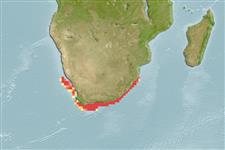Elasmobranquios (tiburones y rayas) (sharks and rays) >
Carcharhiniformes (Ground sharks) >
Scyliorhinidae (Cat sharks) > Scyliorhininae
Etymology: Poroderma: poros (Gr.), hole or passage; derma (Gr.), skin or hide, allusion not explained nor evident (Smith proposed name without a description). (See ETYFish); pantherinum: Latin for leopard-like, referring to its variable leopard-like spots, stripes and blotches. (See ETYFish).
Environment: milieu / climate zone / depth range / distribution range
Ecología
marino asociado a arrecife; rango de profundidad 0 - 256 m (Ref. 5578). Subtropical; 28°S - 36°S
Southeast Atlantic: Saldanha to central Natal, South Africa.
Tamaño / Peso / Age
Maturity: Lm ? range ? - ? cm
Max length : 84.0 cm TL macho / no sexado; (Ref. 244); 73.0 cm TL (female)
Short description
Morfología | Morfometría
Espinas dorsales (total): 0; Radios blandos dorsales (total): 0; Espinas anales 0; Radios blandos anales: 0. A stocky shark with long nasal barbels and a highly variable color pattern of black spots, rings and lines in horizontal rows on a grey to whitish background; white below (Ref. 5578). There are 3 different forms, the typical 'pantherinum' with lines and rosettes of spots, and two extreme forms, 'marleyi' with large dark spots (formerly considered a separate species), and 'salt and pepper' with small, densely packed black spots, intermediates between these extremes are extremely common (Ref. 5578).
Found on or near the bottom of warm-temperate waters, from the intertidal zone to 256 m (Ref. 5578). Prefers rocky reefs (Ref. 5578). Nocturnal (Ref. 244). Feeds on small bony fish, crustaceans, octopus and polychaete worms (Ref. 5578). Oviparous (Ref. 50449). Readily kept in captivity (Ref. 244).
Life cycle and mating behavior
Madurez | Reproducción | Puesta | Huevos | Fecundidad | Larva
Oviparous, produces one egg per oviduct (Ref. 5578). Embryos feed solely on yolk (Ref. 50449).
Compagno, L.J.V., D.A. Ebert and M.J. Smale, 1989. Guide to the sharks and rays of southern Africa. New Holland (Publ.) Ltd., London. 158 p. (Ref. 5578)
IUCN Red List Status (Ref. 130435)
Threat to humans
Harmless
Human uses
Pesquerías: pesquerías de subsistencia; pesca deportiva: si
Más información
Age/SizeCrecimientoLength-weightLength-lengthLength-frequenciesMorfometríaMorfologíaLarvaDinámica larvariaReclutamientoAbundanciaBRUVS
ReferenciasAcuiculturaPerfil de acuiculturaRazasGenéticaElectrophoresesheritabilidadEnfermedadesProcesamientoNutrientsMass conversion
Herramientas
Special reports
Download XML
Fuentes de Internet
Estimates based on models
Preferred temperature (Ref.
123201): 12.4 - 22.1, mean 16.3 °C (based on 31 cells).
Phylogenetic diversity index (Ref.
82804): PD
50 = 0.7500 [Uniqueness, from 0.5 = low to 2.0 = high].
Bayesian length-weight: a=0.00263 (0.00139 - 0.00497), b=3.21 (3.04 - 3.38), in cm total length, based on LWR estimates for this (Sub)family-body shape (Ref.
93245).
Nivel trófico (Ref.
69278): 4.1 ±0.57 se; based on food items.
Resiliencia (Ref.
120179): Bajo, población duplicada en un tiempo mínimo de 4.5-14 años (Fec assumed to be <100).
Fishing Vulnerability (Ref.
59153): Moderate to high vulnerability (54 of 100).
Nutrients (Ref.
124155): Calcium = 7.11 [1.51, 36.84] mg/100g; Iron = 0.352 [0.091, 1.024] mg/100g; Protein = 19.2 [16.2, 22.3] %; Omega3 = 0.125 [0.052, 0.290] g/100g; Selenium = 15.6 [4.5, 47.7] μg/100g; VitaminA = 36.5 [12.1, 119.9] μg/100g; Zinc = 0.539 [0.250, 1.132] mg/100g (wet weight);
